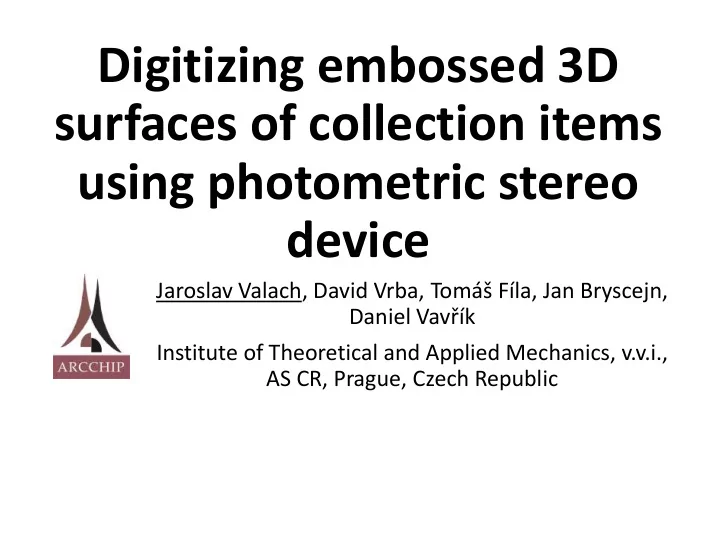

Digitizing embossed 3D surfaces of collection items using photometric stereo device Jaroslav Valach, David Vrba, Tom áš Fíla, Jan Bryscejn, Daniel Vavřík Institute of Theoretical and Applied Mechanics, v.v.i., AS CR, Prague, Czech Republic
Surface topography determination - an important class of measurement tasks • Goal - 3D topography of (usually) ‘flat’ specimen • Other suitable methods (e.g. fotogrammetry, grid projection methods, laser scanning...) • Shape from shading (Horn 1978) • Fundamental principle of the method states that it is possible to deduce surface topography from photometric measurement.
Photometric stereo • Natural shadowing of object helps human eye to “read” volumetric data. • Volumetric data from one image, negligible parallax. • The presented optical method utilizes the same principle for data collection to built ‘virtual copies’ of 3D surfaces of studied bodies.
Photometry Stereo • Fundamental principle of the method is based on direct relation between inclination of surface normal of given point from direction of incident light and the relative brightness of the point captured on image • Principle of the method: intensity of reflected light is determined by the angle between surface normal and direction of incident light : I=k. r .( n , s ).I 0 , p=dz/dx, q=dz/dy, n=(-p, -q, 1) (Linear dependence between surface orientation and intensity of reflected light) • The sensitivity of the method is independent on the distance to the measured object . (vs. photogrammetry, astronomy - craters on the planet surface) • Therefore it is possible to deduce surface topography from photometric measurement „integration“ of slopes into heights. • Assumptions • Collimated light • “ Lambertian ” surface • Non reflective surface • No self-shadows on the surface
Surface Normals • Image of surface normals - “needle map” • Surface normals yields important information on surface quality, their distribution is directly related to surface roughness . • The surface slopes derived from normals can be integrated . The result is surface topography. • Necessity to recalibrate the height profiles.
CPS implementation • Three variables describe the surface: slopes in two orthogonal directions and reflectivity (albedo) • Surface illumination from three directions forms set of three equation for three unknown variables • Encoding three images (scenes) into one . Three different monochromatic colors of illumination and three colors in Bayer filter of digital camera • Height resolution is related to grey bit resolution of image....
Development of portable models of device
CPS on loading and measuring device
Photometry stereo – current stage of development • Automatic, computer controlleddevice • Several degrees of freedom: • Illumination rotation (C) • Vertical movement of camera (E) • Planar movement of specimen ’s stage (D) • Goals: • acquire large number of images • “stitch” data for larger specimens
Examples of results – small objects and surface reliefs Coin Factured surface of natural stone
Experimental application of CPS Strain field in front of growing crack Principal strain 2 field Surface with markers A B C Deformations in in-plane (A, B) and out-of-plane (C) directions
An example of stone degradation measurements Left - Pair of photometric images of sandstone’s surface prior and after artificial weathering. Middle and right part - Surface gradients before and after weather cycling. Higher roughness was observed for a weathered surface.
Cuneiform tablet by CPS
Fossils - Trilobite
Other uses of photometry stereo • Applicable on flat samples with relief surface • Surface inspection - corrosion, wear • Microtopography reconstruction in SEM • Cuneiform tablets • Embossed objects, coins, seals, carvings… • Monitoring of cultural heritage buildings surface (soiling, encrustation)
+ + = Thank you for your attention. Contact: valach@itam.cas.cz
Recommend
More recommend